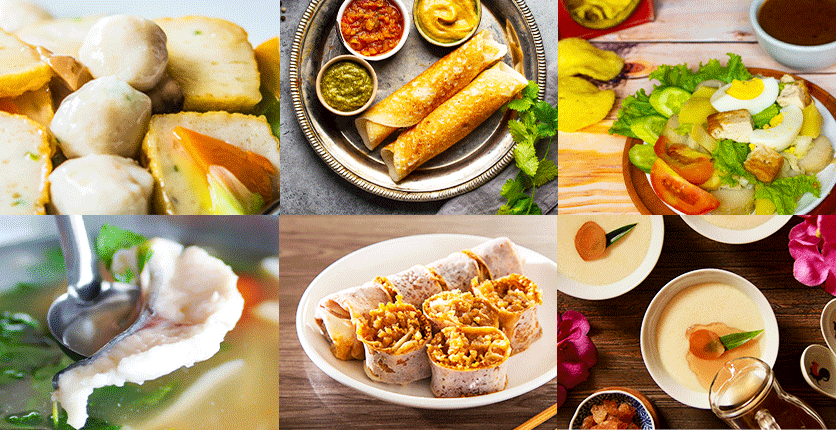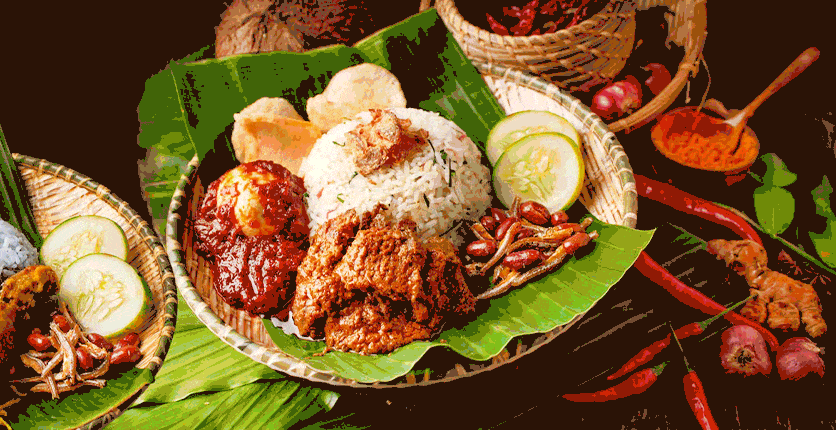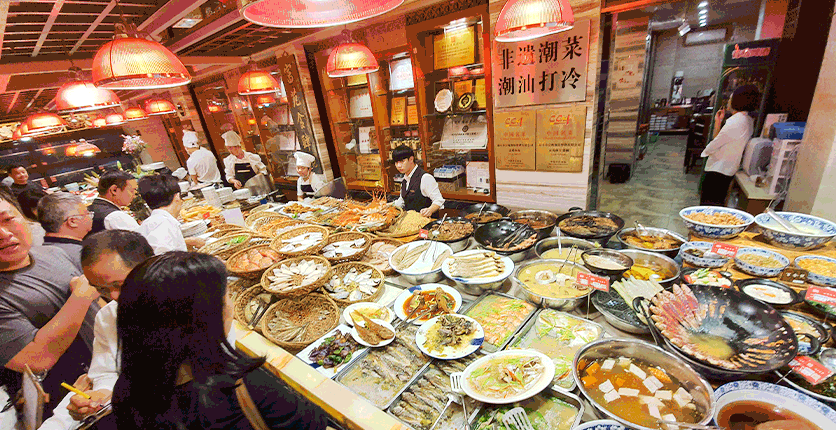Hawker dishes aren’t generally known for being wholesome, but a few do stand out for the healthier ways they’re cooked or the nutritious ingredients they contain. Still, is it a good idea to eat them several times a week? And what can you do to boost their nutritional value? Fung Hui Min, a nutritionist at nutrition consultancy company Health Can Be Fun, tells you how to make these five popular dishes part of a healthier diet. “You shouldn’t have to forgo your favourite hawker meals in order to enjoy a balanced diet,” she says. “Just consume everything in moderation and make healthier choices when eating out.”
Popiah

These thin rice crepe rolls are filled with braised turnip, chilli sauce, grated hardboiled egg, lettuce, chopped peanuts and flour crisps. It makes a popular light lunch or snack.
Nutrition per serving (two rolls):
Calories: 568
Protein: 26.1g
Total fat: 32.3g
Saturated fat: 5.8g
Cholesterol: 207.6mg
Carbohydrate: 41.6g
Dietary fibre: 7.6g
Sodium: 1620mg
Hui Min says: “This is a well-balanced dish, with ingredients from the different food groups. However, it might not be filling enough due to its low carbohydrate and fibre content. It’s also high in sodium, because of the flour crisps. It’s recommended that individuals aged 13 years and older consume no more than 1500mg of sodium a day, so I’d ask for less or no flour crisps, no chilli sauce, and no extra condiments to bring the sodium content down. I’d also request for less chopped peanuts, which are high in total and saturated fat. To make the dish more nutritious, ask for more lettuce. You may wish to have the popiah with a healthy smoothie or some fruit, for additional fibre.”
Yong Tau Foo

Typically enjoyed for lunch or dinner, a standard bowl might contain fish paste-stuffed boiled tofu, fish paste-stuffed fried tofu puff (taupok), fried fish ball, fish paste-stuffed red or green chilli, fish paste-stuffed lady’s finger, a bundle of kangkong (water spinach), cuttlefish, and a chicken sausage.
Nutrition per serving (one bowl):
Calories: 265.7
Protein: 34g
Total fat: 12.6g
Saturated fat: 3.6g
Cholesterol: 206.1mg
Carbohydrate: 3.7g
Dietary fibre: 3.9g
Sodium: 1154.5mg
Hui Min says: “This dish is protein-rich and low in carbohydrates. It’s a good source of unsaturated fat but contains a high amount of sodium. The good thing about yong tau foo is that it has the potential to be a healthy meal because you can choose what goes into it. So, avoid deep-fried or pre-fried options like the taupok and fried fish ball. Instead, opt for boiled items like the white tofu and boiled fish ball. The chilli sauce served with this dish is high in sodium and fat, so I’d omit this condiment. Order a bowl of brown rice or rice noodles for carbohydrates, but bear in mind, this’ll increase the total calorie count of the meal and your carbohydrate intake.”
Tau Huay
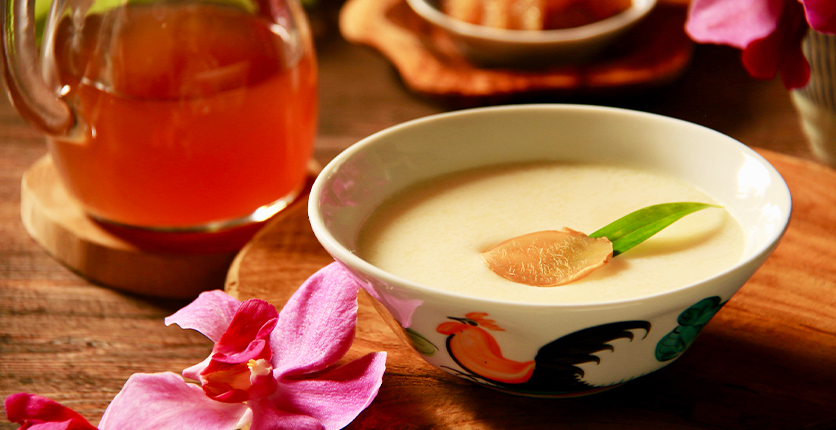
This sweet treat is often enjoyed for breakfast or as a dessert. The soya bean curd is topped with sugar syrup.
Nutrition per serving (one bowl):
Calories: 182.9
Protein: 7.1g
Total fat: 1.9g
Saturated fat: 0.3g
Cholesterol: 0mg
Carbohydrate: 34.4g
Dietary fibre: 0.9g
Sodium: 18.6mg
Hui Min says: “Tau huay is quite healthy, but if you want to make it healthier you can ask for less syrup, or substitute the syrup with honey, which has more nutritional value.”
Sliced Fish Soup
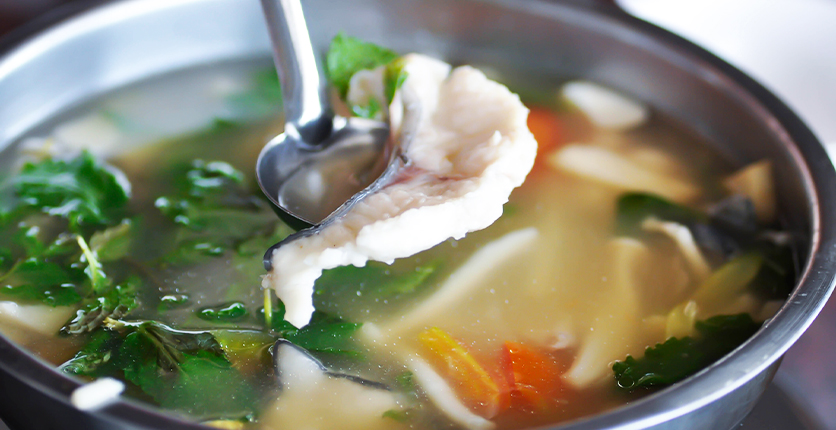
Hearty and comforting, this dish features fish slices, rice noodles, tomato wedges and lettuce in a milky fish-based broth. It’s sometimes garnished with fried shallots.
Nutrition per serving (one bowl):
Calories: 342.9
Protein: 26.1g
Total fat: 6.5g
Saturated fat: 3g
Cholesterol: 0mg
Carbohydrate: 46.1g
Dietary fibre: 3.5g
Sodium: 1653.1mg
Hui Min says: “This dish has no cholesterol but it’s high in sodium because of the broth. It’s quite well balanced because it contains foods from the main food groups – leafy vegetables (lettuce), carbohydrates (noodles) and meat (sliced fish). The milk in the broth gives the dish calcium. White-flesh fish is a good source of protein, unsaturated fat and vitamin D, which is known to increase calcium absorption in the body. To make this dish more nutritious, choose sliced fish over fried, which is high in saturated fat. I’d also add bittergourd for extra soluble fibre and antioxidants, and green leafy vegetables like chye sim for extra B vitamins. Consider finishing only half the broth to reduce your sodium intake.”
Masala Thosai

Originating from South India, this dish is made up of a sour rice- and lentil-based crepe stuffed with spicy potatoes and cauliflower. It sometimes comes with a side of curry, which may contain chicken.
Nutrition per serving (one masala thosai with chicken curry):
Calories: 897.7
Protein: 72.7g
Total fat: 33.4g
Saturated fat: 9.9g
Cholesterol: 179.6mg
Carbohydrate: 72.4g
Dietary fibre: 14.5g
Sodium: 1441.2mg
Hui Min says: “A high-energy, high-protein dish, masala thosai is also a good source of dietary fibre. However, I’d be wary of the sodium level, which exceeds dietary guidelines. To reduce the sodium, skip the side of curry and have just the stuffed thosai alone. If possible, request for the crepe to be fried in safflower or sunflower oil – these are lower in saturated fat and rich in healthier polyunsaturated fat. Look out for the oil colour – it should be fresh yellow, not dark.”
Gado-Gado

This Indonesian salad usually contains hardboiled egg, lontong (rice cake), deep-fried tempeh, deep-fried tofu, boiled potatoes, green beans and beansprouts, topped with a peanut-based sauce and fried prawn crackers.
Nutrition per serving (one plate):
Calories: 1609
Protein: 68.1g
Total fat: 87.3g
Saturated fat: 31.5g
Cholesterol: 339mg
Carbohydrate: 137.6g
Dietary fibre: 31.2g
Sodium: 2400.9mg
Hui Min says: “Despite the serving of vegetables, this is actually an unhealthy dish as it’s high in calories, fat, cholesterol and sodium, all of which can increase your risk of several diseases. It exceeds the daily recommended intake for saturated fat, cholesterol, fibre and sodium. I suggest asking for the tempeh to be baked rather than deep-fried, to reduce the total fat and saturated fat content. If this isn’t an option, eat only half the tempeh given. Ultimately, tempeh is still the main protein source of the dish, so it should not be omitted when striving for a balanced meal. I’d also leave out the prawn crackers as it contributes a substantial amount of sodium to the dish. Request for more green beans, beansprouts and potatoes to balance the meal, and don’t consume the yolk of the egg to lower the cholesterol intake. Try to eat less of the sodium-rich peanut sauce.”
What are your favourite healthier hawker dishes? Share them with us at magnsman@sph.com.sg!
